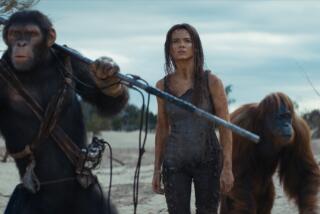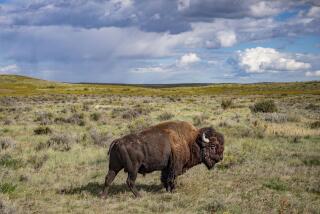BOOK REVIEW : Trio’s Tale of Punishing Search for Great Ape Has a Lot of Bite : OTHER ORIGINS; The Search for the Giant Ape in Human Prehistory <i> by Russell Ciochon, John Olsen and Jamie James</i> Bantam Books $22.95, 262 pages
- Share via
What do you call a King-Kong-sized North Vietnamese ape? “Giganto”--if you find the animal, that is. But these three authors don’t, and their book is a classic--if elegantly written--bait-and-switch.
The giant ape is known to have existed only through “dragon bones,” fossils bought from Chinese druggists who, to this day, grind them up to treat impotence and other maladies. “Other Origins” describes the authors’ fruitless pursuit of their long-extinct quarry into the remote, Communist-held highland of Southeast Asia.
To tantalize the reader, the authors conjecture that the earliest humans, fossils of whom they found on the expedition, suffered a devastating and permanent psychological blow on first seeing Giganto.
The authors wonder whether the traumatic experience may have even entered the unconscious of the entire human race in the form of the Giant Ape myth, which persists today worldwide as Bigfoot, Sasquatch, Yeti, the Abominable Snowman and the Wild Man of China, to name the most popular incarnations.
With the readers thus firmly in tow, the authors go looking for fossil evidence of the prehistoric first encounter between the earliest humans and the largest ape ever to have lived. The scene they imagine for that fateful initial contact is a stand of bamboo, the giant apes’ favorite food.
“The two species are eyeball to eyeball for the first time. The apes loom to a height of 10 feet--more than twice the height of the men!--and weigh well over 1,000 (pounds). . . . They are fist-walkers; one of them lopes a few gigantic steps to get a closer look at the group of men. . . . Small yellow eyes burn in its skull as it takes in the sight of its furless cousins. A half-eaten bamboo stem hangs from its gaping maw.”
Despite the scientists’ imagination and zeal, however, and presumably to the disappointment of the National Geographic film crew on hand to record the discovery, they find no trace of the giant ape in their monthlong dig in a system of caves in the hinterlands of northern Vietnam. They do, however, find something they claim is even more important: the first Southeast Asian fossils (a few teeth) of the direct ancestor of modern humans, Homo erectus.
The ability to marshal such skimpy fossil evidence to dramatize such a bold hypothesis is a key survival skill of scientists who make their careers in the contentious field of human origins. Success equals financial support (the present expedition was entirely underwritten by National Geographic).
The three authors have thrust an idea of their own into this hotly contested spotlight: Humans may have originated in Asia after all. That notion was widely accepted in the last century after archeologists found the Peking Man and Java Man, but was abandoned by the 1960s, the authors say, when the Leakey family’s discoveries tipped the balance decisively toward Africa.
“Other Origins” reads like a literate field notebook, a piquant, episodic blend of character sketches, travelogue and science. Jamie James, the writer in the trio of authors, who presumably produced most of the text and smoothed out the scientists’ contributions, is a well-credentialed magazine science writer, and he memorably portrays his scientist co-authors and the backdrop for their work.
As the researchers clear their bureaucratic hurdles and move into the field, Hanoi’s beautiful but hauntingly empty tree-lined streets and moldy French colonial townhouses give way to the sweltering bamboo villages of the highland, where the women dress in brightly colored raw silk and the men hunt with bows and arrows. In one village, where an 500-pound American bomb is used as a dinner gong, a young man proudly shows the researchers his bamboo crossbow, with its intricate trigger mechanism of carved bone. The irony is not lost on the authors.
Leavening their text with incidents such as this, the authors invite the reader to share in the scientific work. Readers who want to explore seriously such questions as “Who are we?” and “Where do we come from?” will find this book a delight. They will probably even forgive the authors their circus-sideshow technique of promising a fantastic hairy monster, then delivering--along with a brilliant monologue--only a handful of teeth.
Next: Jonathan Kirsch reviews “Out of My Life and Thought: An Autobiography” by Albert Schweitzer (Henry Holt).
More to Read
Sign up for our Book Club newsletter
Get the latest news, events and more from the Los Angeles Times Book Club, and help us get L.A. reading and talking.
You may occasionally receive promotional content from the Los Angeles Times.










